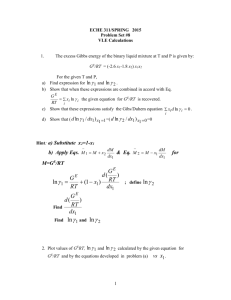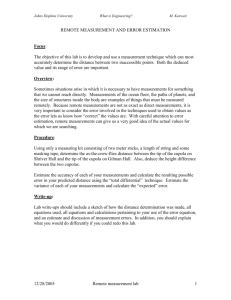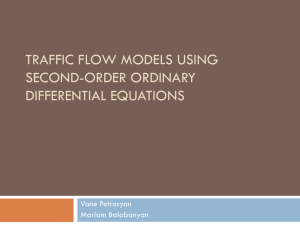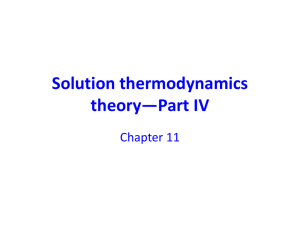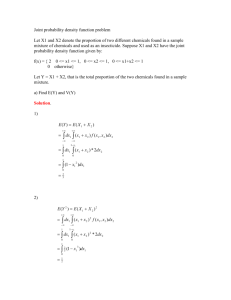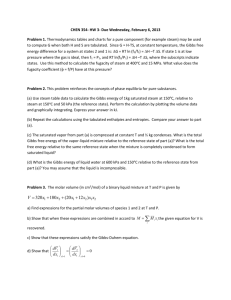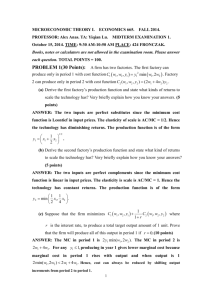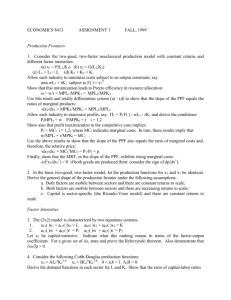Chapter 14-part III
advertisement
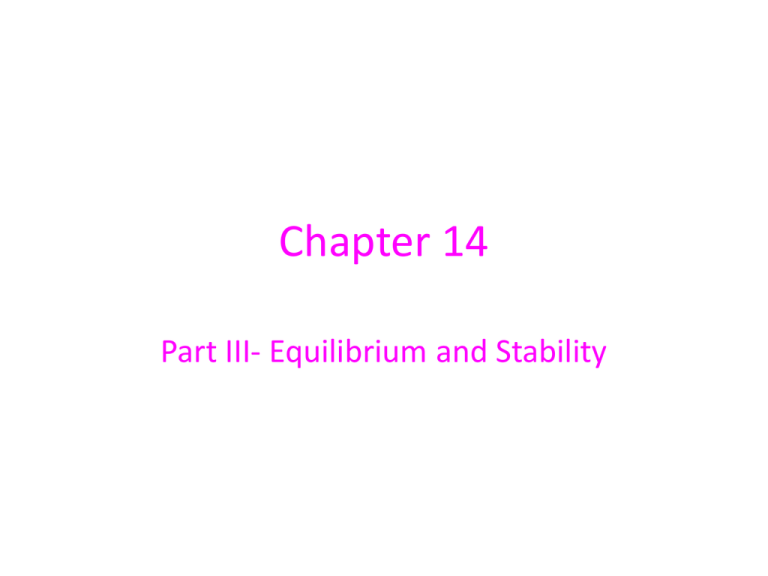
Chapter 14 Part III- Equilibrium and Stability A system with n components and m phases • Initially in a non-equilibrium state (mass transfer and chemical reactions may take place) • T and P are uniform • System is in thermal and mechanical equilibrium with surroundings • What changes may happen to the system? • What will be the final state of the system? Changes to the system translate to: • Heat exchange • Expansion work dS surroundings dQsurr dQ Tsurr T • By the second law, what happens to the entropy? dSsys + dSsurr > 0 dSsys - dQ/T > 0 dSsys > dQ/T dQ < T dSsys By the first law, dUsys =- PdVsys + T dSsys dUsys + PdVsys < T dSsys , or dUsys + PdVsys -T dSsys < 0 dUsys + PdVsys -T dSsys < 0 • Valid for any closed system • The inequality determines the direction of change between non-equilibrium states • The equality holds for changes between equilibrium states (reversible) dUsys + PdVsys -T dSsys < 0 • Special cases: – At V and S constant (dUsys)SV < 0 – At U and V constant (dSsys)UV > 0 Process at constant T and P dUTP+ d(PV)TP –d(TS)TP < 0 d(U+PV-TS)TP < 0 (dG) TP < 0 All irreversible processes at constant T and P tend to decrease the Gibbs free energy Equilibrium criterion • For a closed system at constant T and P, the Gibbs free energy is a minimum • Given an expression for G, we find the set of composition values that minimize G At equilibrium, differential changes may occur • The system is not static !!! • At constant T and P changes may happen but they do not change G. • Therefore: (dG) TP = 0 DGmixing = G – SxiGi If the system is stable, G must decrease, therefore G < SxiGi , G – SxiGi < 0 For curve II, the system has a lower G by splitting into two phases than in a single phase (at compositions between x1a and x1b) Stability criterion for a single phase binary system • At constant T and P, DG and its first and second derivatives must be continuous functions of x1, and the second derivative must everywhere be positive d DG 0 constant T and P 2 dx1 2 d (DG / RT ) 0 constant T and P 2 dx1 2 Alternative stability criterion: Relation to GE • Since DG GE x1 ln x1 x2 ln x2 RT RT d 2 (DG / RT ) 1 d 2 (G E / RT ) 2 dx1 x1 x2 dx12 d 2 (G E / RT ) 1 2 dx1 x1 x2 At constant T and P Other alternative stability criteria d 2 (G E / RT ) 1 2 dx1 x1 x2 GE x1 ln 1 x2 ln 2 RT d 2 (G E / RT ) 1 d ln 1 0 2 dx1 x2 dx1 Alternative criteria, at constant T and P, valid for each of the components: d ln 1 1 dx1 x1 dfˆ1 0 dx1 d1 0 dx1 How the stability criteria affect VLE? dfˆ1 ˆ d ln fˆ1 f1 0 dx1 dx1 but fˆ 0 1 d ln fˆ1 0 dx1 How is the criterion for component 2? d ln fˆ1 d ln fˆ2 0 dx1 dx1 For an ideal gas mixture, you can show that d ln fˆ1 d ln fˆ2 1 dy1 dx1 dx1 y1 y2 dx1 Then the stability criterion is dy1/dx1 > 0 What does it mean for a y-x diagram? For the liquid phase, at constant T and P Gibbs Duhem d ln fˆ1 d ln fˆ2 x1 x2 0 dx1 dx1 Low pressure VLE, assume ideality of gas phase, you can show 1 dP ( y1 x1 ) dy1 P dx1 y1 y2 dx1 What can we say about the sign of dP/dx1? dP dP / dx1 dy1 dy1 / dx1 Therefore, what is the sign of dP/dy1? What happens at an azeotrope?
